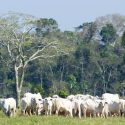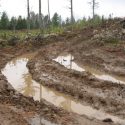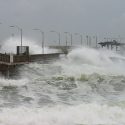Classes in the park unite middle schoolers with college students, nature
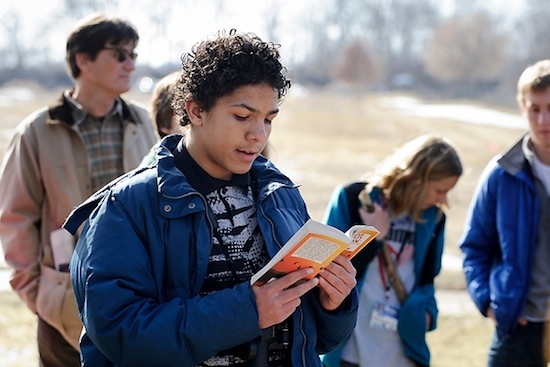
During group reflection time, 8th grade student Nicolas Dupaty reads a passage from Aldo Leopold’s famed naturalist book “A Sand County Almanac.”
Photo: Jeff Miller
Trish O’Kane had reached a dead end. It was her first day teaching a capstone course in environmental studies at the Nelson Institute, and she was ready to forge ahead with a two-hour “college-style” lesson plan.
Meanwhile, the students, from Sherman Middle School on Madison’s Northeast side, were rolling sideways down the big hill at Warner Park.
The idea seemed sound: juniors and seniors from UW–Madison would focus on birds in the natural world during a two-hour indoor class on campus every Wednesday morning. In the afternoon, they would meet students at Sherman and spend two hours at Warner.
Instinctively, O’Kane dropped her structured lesson plan and changed course. The kids had just spent a day in school, and they had energy to burn. She could teach about birds and the environment in a more subtle — and more effective — manner.
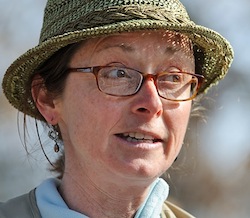
O’Kane
“We have to meet them where they are,” says O’Kane, a graduate student who lives in the neighborhood and is a prime mover in Wild Warner, an effort to sustain nature and promote nature appreciation in the 200-acre park. Best known for the July 4th extravaganza Rhythm & Booms, Warner also hosts a wetland, fields and a forest.
And at that moment, Last Child in the Park: How Kids & Birds Can Save the Planet took flight as a program in cooperative, cross-generational, outdoor learning. Last Child was created as part of a larger Nelson Institute initiative, supported by Charlotte Zieve, a Nelson donor and alumna, and others to address diversity, justice and the future of environmental work.
The class has three legs: students from Sherman, environmental studies seniors from UW–Madison, and the park itself. On a breezy March day, 26 middle-schoolers and 18 UW students are pulling a few plastic sleds up the hill. Many are doing the obvious thing down the other side. Others are flying kites. In coming weeks, as the class continues, the students will experience early spring and warmer temperatures.
Danny Munguia, 13, who lives in the neighborhood, signed up because he wanted to be outside. “I liked it the first day. I’ve seen how Warner changes, how it looks in the different seasons. My favorite is summer, when I can hear the birds. Now it’s cold, and I don’t hear anything.” But on this day, Munguia lopes downhill through the fresh, knee-high snow to show off a teepee-shaped “fort” that is, to him, a special place in the park.
The class, he says, “gets you outside instead of being at home and doing nothing. You start to know what’s around you.”
Rachel Vorlander, a UW–Madison senior in community and environmental sociology, says she likes to work with students and likes birding, but doesn’t know much about birds. “It’s an opportunity for us to learn from the students, and with the students, and hopefully for them to learn from us.”
“The first time through, I did not see what was important,” says Tony Abate, a senior in philosophy and environmental studies. “I did not know what I was doing, did not see what a difference I was making.” At the concluding class of the last session, he says, “One of ‘my’ boys could not look at me, could not tell me goodbye, and I realized it meant a lot more than I thought.” Abate chose to repeat the class this semester.
“The college students are establishing a relationship; the middle-school students have someone who listens, who is there for them, and that’s very important.”
Jack Kloppenburg
As some kids continue sledding, others pair off to talk, walk or look at nature with their adult mentors. O’Kane admits that it can be difficult to quantify the learning, until she hears the kids teaching adults what they have absorbed about nature and the environment.
The lessons tend to focus on bird life in the park, but “birds are an avenue, a road into the relationship,” says O’Kane’s advisor, Jack Kloppenburg, professor of environmental and community sociology. “The college students are establishing a relationship; the middle-school students have someone who listens, who is there for them, and that’s very important.”
From observation, understanding and love comes citizenship, O’Kane says. For example, after park staff cut down a large, hollow elm that they adjudged hazardous but was a favorite hiding place, the middle-schoolers wanted to raise the issue about another tree before the Parks Commission. Eleven-year-old Dakari Gilbert went to a commission meeting, O’Kane recalls, and told the members, “I am not used to talking to strangers, this is very emotional. On my birthday, my family comes and we have cake under my birthday tree. It’s old: Please don’t cut it down!”
The experience, says O’Kane, teaches that “when something changes and it hurts, it’s not enough to cry, you have to do something about it. It teaches them to be citizens — and that offers a lesson to the college students.”
The park commissioners heard the message, says commission member Bill Barker, an associate dean at UW–Madison. “For them to come forth even though they are scared shows they are learning to advocate for something that’s important for them.” Coming from an 11-year-old boy, Barker says, “it’s very powerful; very effective.”
Barker notes that as Last Child in the Park exposes kids to an educational institution that is seldom on their radar screens, and thinks that a campus facing continuing diversity challenges will benefit in the long term. “When these kids grow up, they are more likely to think about UW–Madison,” he says. “This kind of program is helpful for UW, for our students, for the kids at Sherman, for the park. Everybody benefits.”
Tags: environment, outreach, schools

